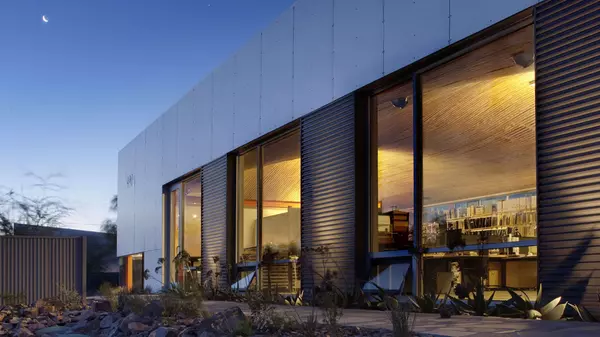San Diego ready to make a deal to turn 101 Ash St. into low-income housing
The city of San Diego is preparing to lease its office tower at 101 Ash St. on a long-term basis, at no upfront cost, to a development team that plans to spend hundreds of millions of dollars to convert the property into housing for low-income families.
On Wednesday, San Diego’s Land Use and Housing Committee will consider the transaction, which includes a 60-year ground lease with housing developers MRK Partners and Create Dev LLC.
The proposed deal values the asbestos-ridden tower, which has sat empty for the better part of a decade, at $45.6 million. Instead of requiring immediate payment, the city will issue a seller’s note to recoup the sum, plus 4% simple interest applied annually, over a 55-year loan term, with no payments anticipated until year 15.
“It’s hard to disassociate from the past, but the deal itself is solid,” said Christina Bibler, the director of San Diego’s Economic Development department. “We negotiated with the developer to go into a structure that the city is very comfortable with and does regularly.”
The development team framed the deal as a way for the city to create more low-income housing, dump the financial burden of the unoccupied property and secure a money-making property at the end of the lease.
“This is a solid opportunity for this building to generate a positive financial outcome for the city while providing much needed affordable housing and community benefit — versus having it sit and drain resources from a constrained city budget,” said Kelly Modén, president of Create Dev and a San Diego Planning Commissioner.
The deal is moving forward even though key transaction documents — the ground lease and associated contracts — were not ready in time for the committee hearing. The committee meeting could tee up approval by the full City Council at the end of July.
The timing is meant to ensure that the development team can compete for state-allocated tax credits in September, Bibler said.
In total, the developer expects to use $114.7 million in tax credit proceeds to fund the $250.3 million conversion project, according to the financial model reviewed by city consultant Keyser Marston Associates, Inc.
Built in 1967, the 21-story office tower at 101 Ash St. in downtown San Diego was the longtime home of Sempra Energy until the utility company exited the building in favor of a new headquarters in mid-2015. In early 2017, the city entered into a 20-year, lease-to-own deal to acquire the building and use it for a portion of its downtown workforce. The transaction, however, turned into a civic blunder after a botched remodel effort resulted in asbestos contamination and other issues.
In 2022, the city bought out the lease for $86 million in a controversial settlement agreement. Despite being empty, the building requires regular upkeep and security. The city has budgeted $2.5 million for property management costs in the fiscal year that starts on July 1.
In January, after a previous effort to solicit interest in the site, San Diego City Council members selected the Create-MRK team to convert the office building into a residential tower with first-floor shops.
Create is a one-person company, run by Modén, that specializes in multifamily housing. Last week, Modén set up a distinct limited liability company, MKAFF Housing LLC, for the 101 Ash St. deal.
Los Angeles-based MRK is a privately held real estate investment company singularly focused on affordable housing development, including hotel- and motel-to-residential conversion projects. The company was started by President Sydne Garchik in 2015.
The women, who have partnered on previous projects, are proposing to remake the office building with 247 residential units deed restricted for families earning 30% to 80% of the area median income, or what’s considered affordable housing. The area median income for a family of four in San Diego County is $130,800.

Affordable housing is a specific product type that relies heavily on a combination of local, state and federal subsidies. Rental rates are set by the U.S. Department of Housing and Urban Development each year and are specific to each renter’s family size and annual income.
The project also includes three unrestricted manager units, 25,000 square feet of retail space and a 4,000-square-foot child care center. The retail space is described as a food hall in the Keyser Marston report.
The developer anticipates spending more than $1 million per unit, according to the financial model reviewed by the city’s consultant. The cost reflects big-ticket expenses such as $40.1 million for asbestos abatement and interior demolition work, $67 million for the residential remodel, $18.5 million in labor costs associated with the developer paying prevailing wage rates, $20 million in loan and interest charges, and a $24.5 million fee pocketed by the developer.
The price-per-unit is much higher than other tax credit-funded projects for existing properties, but is in line with costs associated with new construction projects that use government subsidies, said Norm Miller, a real estate professor emeritus at the University of San Diego.
The 101 Ash St. project is reliant on the developer receiving $82.5 million in low-income housing tax credits. The tax credits are a federal subsidy intended to ensure that developers can rent units to income-qualified households for below-market rates. They are doled out on a rolling basis by the California Tax Credit Allocation Committee. If the developer is awarded the tax credits, it would sell them to private investors to secure project funding.
The Create-MRK group is also banking on receiving $32.2 million in tax credits associated with historic properties, although 101 Ash St. is not yet designated as a historic property.
Tax credit awards are highly competitive, with multiple firms competing for a limited pool of funds, meaning the make-or-break financing source is anything but certain. The ground lease gives the developer a two-year window to secure financing, according to a staff report prepared for the committee meeting.
San Diego is also helping to boost the developer’s chances by underwriting the project through the $46.5 million seller’s note. The note is a residual receipts loan that closes the project’s financing gap.
As proposed, the developer will start to repay the loan around year 15, when the project is refinanced. The city will then receive annual payments equal to 50% of the project’s rental proceeds, minus expenses, with money deposited in the city’s general fund.
“There will be what is called a capital event, meaning they’ll refinance, and the city will receive 2% at that time,” Bibler said. “Then the tax credit investors will exit, and (the property) will continue to be operated and maintained by the (Create-MRK) partnership for the duration of the lease.”
The city, she said, is not requiring the developer to make an upfront lease payment because of the high cost to convert the office tower into 100% affordable housing.
“The city is willing to contribute the value of the building for tax credit purposes, and then will receive payments back in residual receipts,” Bibler said. “The city receives … the fully improved building that has been owned and operated and maintained to good satisfaction at the end of the lease. So that’s really where the value is created. We don’t lose ownership, and we’ve created public benefit in the interim.”
The city is also not requiring the development team to take an equity stake in the project, meaning the group is not putting any of its own money into the deal.
The proposed 101 Ash St. deal is a product of the city’s past mistakes and the unavoidable costs associated with asbestos abatement, Miller, the real estate professor, said.
“It’s pretty much … just a way to get out from under the $40 million-plus cost to deal with building cleanup,” Miller said. “The developer gets a sweet deal with nice fees and no skin in the game, but they do bring the (tax credits) to the table and that supplies most of the equity. The city benefits in getting rid of a negative asset.”
As for the long-term ground lease structure, Miller said leases, as opposed to outright sales, make sense for cities, counties, universities and school districts when control is beneficial. In 60 years, the building may still have some value, he said.
Categories
Recent Posts











